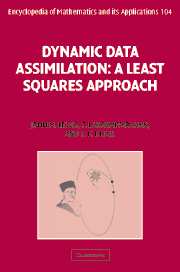Book contents
- Frontmatter
- Contents
- Preface
- Acknowledgements
- PART 1 GENESIS OF DATA ASSIMILATION
- PART II DATA ASSIMILATION: DETERMINISTIC/STATIC MODELS
- PART III COMPUTATIONAL TECHNIQUES
- PART IV STATISTICAL ESTIMATION
- PART V DATA ASSIMILATION: STOCHASTIC/STATIC MODELS
- PART VI DATA ASSIMILATION: DETERMINISTIC/DYNAMIC MODELS
- 22 Dynamic data assimilation: the straight line problem
- 23 First-order adjoint method: linear dynamics
- 24 First-order adjoint method: nonlinear dynamics
- 25 Second-order adjoint method
- 26 The 4DVAR problem: a statistical and a recursive view
- PART VII DATA ASSIMILATION: STOCHASTIC/DYNAMIC MODELS
- PART VIII PREDICTABILITY
- Epilogue
- References
- Index
22 - Dynamic data assimilation: the straight line problem
from PART VI - DATA ASSIMILATION: DETERMINISTIC/DYNAMIC MODELS
Published online by Cambridge University Press: 18 December 2009
- Frontmatter
- Contents
- Preface
- Acknowledgements
- PART 1 GENESIS OF DATA ASSIMILATION
- PART II DATA ASSIMILATION: DETERMINISTIC/STATIC MODELS
- PART III COMPUTATIONAL TECHNIQUES
- PART IV STATISTICAL ESTIMATION
- PART V DATA ASSIMILATION: STOCHASTIC/STATIC MODELS
- PART VI DATA ASSIMILATION: DETERMINISTIC/DYNAMIC MODELS
- 22 Dynamic data assimilation: the straight line problem
- 23 First-order adjoint method: linear dynamics
- 24 First-order adjoint method: nonlinear dynamics
- 25 Second-order adjoint method
- 26 The 4DVAR problem: a statistical and a recursive view
- PART VII DATA ASSIMILATION: STOCHASTIC/DYNAMIC MODELS
- PART VIII PREDICTABILITY
- Epilogue
- References
- Index
Summary
In this opening chapter of Part VI, we introduce the basic principles of data assimilation using the now classical Lagrangian framework. This is done using a very simple dynamical system representing a particle moving in a straight line at a constant velocity, and hence the title “straight line problem”.
In Section 22.1 the statement of the problem is given. First by reformulating this problem as one of fitting data to a straight line, we compute the required solution in closed form in Section 22.2. This solution is used as a benchmark against which the basic iterative scheme for data assimilation is compared. The first introduction to the iterative algorithm (which has come to be known as the adjoint method) for data assimilation is derived in Section 22.3. Section 22.4 describes a practical method for experimental analysis of this class of algorithms based on the notion of Monte Carlo type twin experiments.
A statement of the inverse problem
We begin by describing a common physical phenomenon of interest in everyday life. A particle is observed to be moving in a straight line at a constant velocity, say, α > 0. The problem is to model the dynamics of motion of this particle and then predict its position at a future instant in time, say t > 0.
Let x(t) ∈ ℝ denote the state representing the position of the particle at time t ≥ 0. where x(t0) = x0 is the initial state. Refer to Figure 22.1.1.
In this setup, the dynamics of motion of the particle can be adequately described by the following.
- Type
- Chapter
- Information
- Dynamic Data AssimilationA Least Squares Approach, pp. 365 - 381Publisher: Cambridge University PressPrint publication year: 2006

